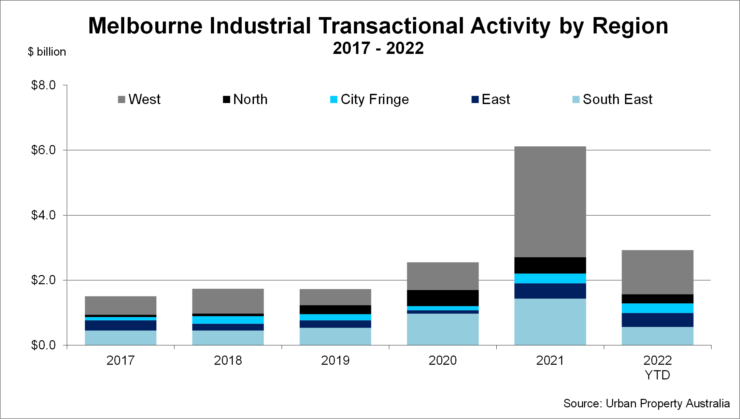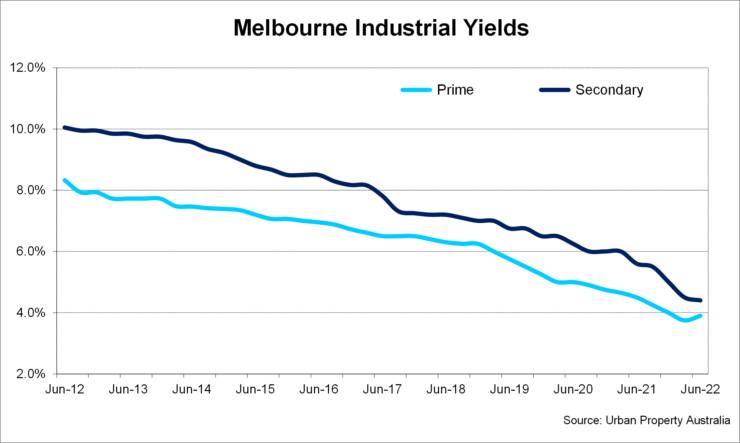Q2 2022 – Melbourne Industrial Market
August 19th 2022 | , Urban Property Australia
- Industrial sales activity has already exceeded $3 billion in 2022 to date with offshore purchasers having accounted for 55% of the volume of the sales;
- The growth of e-commerce has driven tenant demand outpacing new supply, leading to Melbourne’s industrial vacancy rate falling to 1.3%;
- The focus of the tenant demand has been on the Western and South Eastern regions which collectively accounted for 53% of gross take-up;
Industrial Market Summary
The growing penetration of e-commerce has resulted in a significant lift in tenant demand. Retailers and wholesale trade boosted by the lift in non-discretionary spending have led tenant demand followed by logistics occupiers with leasing activity above the long-term average. As the growth of e-commerce has driven tenant demand outpacing new supply, the Melbourne industrial vacancy rate currently stands at 1.3%.
Sales Volume / Yields
With transactional activity in the Melbourne industrial market having surpassed $6 billion in 2021, industrial sales activity has already exceeded $3 billion in 2022 to date. Urban Property research showed that transactional activity in the Melbourne industrial market was focused on the key precincts of the West and South East which collectively accounted for 65% of total sales. Influenced by the major portfolio transactions, offshore purchasers accounted for 55% of the volume of industrial sales in 2022 to date, well above their average annual proportion of sales.
Industrial yields have marginally eased in line with the increasing cost of debt as investors seek to increase their exposure to the sector underpinned by the ongoing growth of e-commerce. Average prime yields have compressed by 60 basis points over the year to June 2022 to average sub-4%. While funding costs remain low and rental growth becomes more pronounced, Urban Property Australia anticipates that yields will remain at benchmark lows as investors aggressively seek investment opportunities.


New Supply / Land Values
With institutional groups increasingly boosting their exposure to the industrial sector, new supply of industrial stock in Melbourne is projected surpass one million square metres for three consecutive years. After an all-time high of 1,200,000sqm of new industrial stock delivered in 2021, Urban Property research forecast that new supply levels will remain elevated with tenant demand robust driven by the growing e-commerce sector. New supply continues to struggle to meet the robust demand from occupiers with 65% of new supply pre-committed. The bulk of the new stock expected to be completed this year is located in the Western (45%) and South Eastern (35%) regions.
Declining land supply coupled with elevated tenant demand is placing upward pressure on land values as owner occupiers compete with institutional owners. Average industrial land values have increased by 60% over the 12 months to June 2022. The scarcity of developable industrial land and improving business outlook is likely to led to further land value growth.
Tenant Demand
The growing penetration of e-commerce has resulted in a significant lift in tenant demand. Retailers and wholesale trade boosted by the lift in non-discretionary spending have led tenant demand followed by logistics occupiers with leasing activity above the long-term average. The focus of the tenant demand has been on the Western and South Eastern regions which collectively accounted for 53% of gross take-up according to Urban Property Australia research.
Vacancy / Rents
Vacant industrial space across the Melbourne market decreased through 2022, as the growth of e-commerce has driven tenant demand outpacing new supply. Urban Property Australia research estimates that Melbourne industrial vacancy rate currently stands at 1.3% as at June 2022 with the South East vacancy rate below 1%.
Rental growth gained momentum across all precincts in the Melbourne industrial market, coupled with a decrease in incentives levels from landlords. The underlying strength in the retail trade and logistics demand is contributing to a rise in leasing activity with strong demand for larger facilities to accommodate automated supply chain requirements.
Prime rental growth has stabilised as a result of substantial new completions. Prime rental growth was led by the Western precinct. Urban Property Australia expects that rents will continue to increase over 2022 as landlords recover the increased costs of new developments.
Copyright © 2022 by Urban Property Australia All rights reserved. No part of this publication may be reproduced in any form, by microfilm, xerography, electronically or otherwise, or incorporated into any information retrieval system, without the written permission of the copyright owner.



